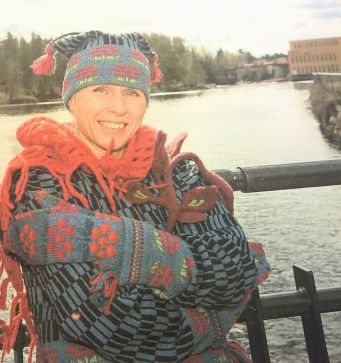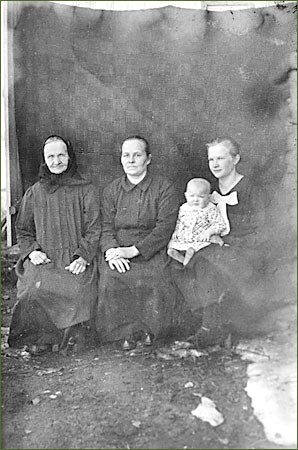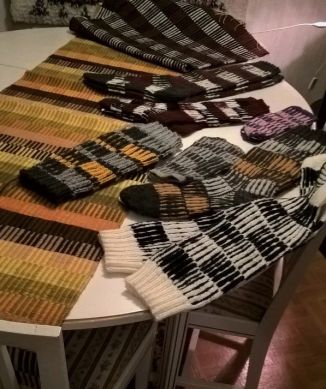Kainuu's peilikäs
| Kainuu's peilikäs | ||||
|---|---|---|---|---|
| In the national inventory | ||||
|
Practitioners and people who know the tradition well

The preservation and continuation of the Peilikäs weaving tradition were significantly influenced by the establishment of Kainuun Kotiteollisuusyhdistys (Kainuu Home Industry Association) and advisory centers in various municipalities in Kainuu. When the activities of Taito Kainuu and Kainuun Pirtti ceased in 2014, the knowledge of the tradition and its artifacts were archived in the collections of the Kainuu Museum and the archives of the city of Kajaani.
The Peilikäs weaving tradition is upheld through textile weaving education in Kainuu's adult education centers and heritage craft courses. In each municipality of Kainuu, there is an adult education center established in the 1970s based on the Act on Liberal Adult Education and its objectives. The qualifications of permanent principals, planning teachers, and full-time teachers are defined by the aforementioned law. These adult education centers are maintained by municipalities, which receive state subsidies for the educational activities based on the Act on Liberal Adult Education.
Each adult education center has a planning teacher or full-time teacher responsible for textile crafts, whose duties include annually developing the curriculum for the subject area in collaboration with weaving and textile work hourly teachers.
Practising of the tradition
Peilikäs is an uneven twill-bound rug with a distinct pattern and often specific colors, closely associated with the Kainuu region. Peilikäs serves as an expression of both craftsmanship and the Kainuu way of life.
The Peilikäs pattern is seen as an iconic symbol of Kainuu in various contexts and is used in commercial settings, graphics, and handicraft products such as mittens, socks, and rugs. Peilikäs rugs are still used as coverings and wall hangings, and they are displayed in museums throughout the Kainuu region, showcasing the textile tradition of this remote and economically modest area.
The traditional physical characteristics of Peilikäs, especially its simple production and the warmth of its structure, have contributed to the continued use and production of this textile tradition. These same attributes have also led to the transformation of Peilikäs into an intangible cultural heritage. While the earliest Peilikäs patterns were recorded in museum collections during the early stages of the national museum system, evolving concepts of folk art and folk crafts excluded eastern and simple everyday objects from museum interest. Particularly, the long-standing use of the object appears to have rendered it non-
historical and therefore difficult to record, transforming it into a traditional handicraft with cultural and museum value.
The background and history of the tradition

The traditional Peilikäs rug is a simple, half-woolen cover textile with a plain weave structure, typically made from locally available materials according to tradition. Peilikäs was used specifically as a bed cover due to its heavy structure and warm materials, making it well-suited for this purpose. In the early 1900s, housewives used Peilikäs to cover the floor mattresses, benches, and beds in the rooms where the household members, workers, and guests slept. Peilikäs was also needed by the men. They used Peilikäs warps to protect the horses and placed Peilikäs blankets on top to provide warmth to passengers sitting in sleighs.
The traditional use and production of Peilikäs rugs continued in Kainuu for a long time. While in Western Finland similar woven textiles gave way to decorative coverlets already in the 1800s, twill-bound Peräpohjola, Lapland, and Kainuu woolen rugs were used as covers until the 1950s. This phenomenon is linked to occasional revivals of traditional livelihoods in a slowly modernizing society. Although craft schools and various courses introduced new materials, weaving patterns, and interior and bedding textiles to Kainuu in the early 1900s, old and self-reliant methods were adopted when they were needed the most. This happened, for example, during the 1930s depression and the 1940s reconstruction period when the production and use of traditional textiles increased.
The first Peilikäs textiles were recorded in the collections of the predecessor of the Finnish National Museum, the State Historical and Ethnological Museum, during the era of national romanticism. In 1894, architects Yrjö Blomstedt (1871–1912) and Victor Sucksdorff (1866–1952) conducted an architectural and ornamental research and collection trip to Russian Karelia. Contrary to their initial plans, the travelers also spent a few days on the Finnish side, in the present-day Kainuu region, where they unexpectedly found interesting, rare, original, and old materials for their research. The researchers were particularly impressed by the skill of local craftsmen and the unique textile patterns found in the region.
Kainuu textiles and Peilikäs rugs remained forgotten for over half a century. Although rugs were collected and studied elsewhere in Finland, such as in Southwest Finland, Ostrobothnia, Satakunta, Häme, and Lapland, general presentations of Finnish folk culture, such as the Finnish Folk Culture Atlas (1976), did not consider Kainuu textiles. It is noteworthy that earlier collections, such as those of Blomstedt and Sucksdorff, did not influence the content of the concept of folk art that emphasized Western Finnish folk culture.
In the 1940s, Peilikäs was rediscovered, thanks to the efforts of home industry developers: the Home Industry Association, the Home Industry Department of the Rural Authority, and home industry associations. They wanted to emphasize the importance of regional patterns and products designed based on them in promoting craftsmanship and livelihoods. In Kainuu, the rugs were brought to attention as part of Kajaani Home Industry Association's 40th-anniversary exhibition at the encouragement of Inspector Toini-Inkeri Kaukonen. Kaukonen emphasized that Peilikäs rugs were genuine, rare, and essential products belonging to the national home industry. When local Home Industry Association director Salme Tervonen also took the matter to heart, a modern rug production based on regional tradition emerged, symbolized by the interior textile Kainuun peilikäs.
The collections of the Finnish National Museum and Kainuu local museums started to include Peilikäs rugs and rug pieces from the 1960s onwards. The acquisitions were related to the post-war revival of regionalism and local heritage work. In this context, the focus was no longer on collecting weaving patterns, but rugs were recorded to document the interiors of Kainuu houses and the disappearing way of life.
At the regional central museum, Kainuu Museum, the cultural heritage value of Peilikäs was manifested during the municipalization of the museum in 1977 when the rug was presented in the museum's basic exhibition as the only textile in its traditional manufacturing and usage context. When regional museum work began in the early 1980s, the need to document and study Kainuu textile heritage was recognized and brought to public attention through the museum's IKI magazine. The themed issue (1/1983) introduced Kainuu rugs as home industry products and described the documentation of rugs into the collections of the Finnish National Museum and the Wetterhoff Home Industry Teaching Institute. These events also contributed to the national publicity and acceptance of Peilikäs. In Ulla Harjumäki's publication "Kankaankutojan sidosopissa – peilikäs" in 1985, Peilikäs is introduced among other Finnish folk rugs under the name "Kainuu’s peilikäs."
In the post-World War II situation, the revival of regionalism in local heritage work emphasized regional aspects in the concept of Finnish craftsmanship. This led to the rediscovery of Kainuu textiles as efforts to develop home industry gained momentum. At that time, Peilikäs became part of the foundation of Finnish craftsmanship, justified by its genuinely Finnish and genuinely Kainuu characteristics. The regional significance of the rug was established through the product Kainuun peilikäs, which was presented as part of the successful business and as a continuation of tradition and local identity.
The transmission of the tradition

Traditionally, the passing down of heritage is nowadays a rare occurrence within families, unlike in the past. The transmission of tradition primarily revolves around weaving courses in the curriculum. The communal spirit of these weaving courses provides a fertile ground for the transfer of tradition. The age range of students is wide, encompassing young and older individuals who have memories of textiles woven at home, along with the memories and stories associated with them. The role of the teacher is crucial in how they are familiar with Kainuu's textile heritage and incorporate it into the course curriculum.
The objectives and contents of weaving courses in adult education centers (kansalaisopistot) emphasize the significance and appreciation of tradition. In these courses, students learn fabric design and construction either individually or in groups under the guidance of the teacher. Assessing one's own work and the work of the group encourages learning and experimentation.
The courses are held in spaces owned by municipalities, community halls, or privately rented premises. Education is organized in accordance with the wishes of the local residents, including in remote places of Kainuu.
Courses at the adult education centers are either for a semester or an academic year, with 80 - 100 hours of instruction per academic year. Weaving courses are offered during the day and in the evening, allowing employed, unemployed, and people of different ages to participate. The course meets once a week under the guidance of the teacher, and once the plan is ready and the work has been started, weaving can continue in one's own time.
In some courses, adults, parents, or grandparents may bring children with them, allowing the children to observe, experience, and participate in various stages of weaving and handicrafts.
During the academic year and at the beginning of the summer vacation, adult education centers also offer weaving and handicraft courses for children and youth. Kainuu adult education centers provide arts and crafts basic education for children and youth according to the curriculum.
Information about the courses is disseminated through the adult education centers' websites, printed course catalogs, local newspapers, and separate course brochures.
At the end of the spring semester, adult education centers organize student work exhibitions, where visitors can also learn from the demonstrations arranged by the students.
The photo galleries on the adult education centers' websites contain videos and images of events and exhibitions.
Weaving, traditional handicrafts, machine knitting, and children's arts and crafts basic education courses in Kainuu adult education centers for the academic year 2022–2023:
Kaukametsän opisto, Kajaani:
· Weaving, three courses (morning, afternoon, and evening)
· Children's weaving, one course
· Specialized handicrafts, three courses (including both hand and machine knitting)
· Machine knitting, one course
· Arts and crafts basic education for children, two courses
Sotkamon kansalaisopisto, Sotkamo, Kuhmo:
· Weaving, six courses (morning and evening)
· Specialized handicrafts, four courses (including hand knitting)
· Arts and crafts basic education for children
Paltamon kansalaisopisto, Paltamo, Ristijärvi:
· Weaving, three courses (morning and evening)
· Knitting, three courses
· Machine knitting, one course
Kianta Opisto, Suomussalmi, Hyrynsalmi:
· Weaving, six courses (morning and evening)
· Traditional handicrafts, four courses (including hand knitting)
· Knitting, two courses
Puolangan kansalaisopisto, Puolanka:
· Weaving, two courses
· Children's handicrafts, two courses
Participation in constructing the Peilikäs fabric is done as a group, with each participant contributing to the work. Details such as warp width, warping, threading, and treadle tie-up are decided collectively. Peilikäs allows each weaver to design their own pattern in terms of materials, motifs, and colors. The same warp can be used to weave wall textiles, cushion covers, table textiles, or fabrics for bags. Peilikäs can be woven with wool yarn, rag strips, or cord yarn.
Peilikäs pattern designs are adapted for both hand and machine knitting. Applying the patterns to fabric printing or ceramic decoration opens up new dimensions.
The future of the tradition
[[Tiedosto:Peilikästaulu, villakude, maalattu puukehys, Marla Lukkari.jpg|pienoiskuva|455x455px|alt=Peilikäs rug on the wall, wool fabric, painted wooden frame, Marla Lukkari|Peilikäs rug on the wall, wool fabric, painted wooden frame, Marla Lukkari] In Kainuun peilikäs textiles, beyond visible shapes, patterns, colors, and objects, there is a timeless, intangible significance. Understanding and valuing a rich history, knowledge, and tradition offer the opportunity for new thinking and creation. The transformation from a
centuries-old utilitarian textile to a decorative textile and, today, into various types of utility textiles and objects, paints a comprehensive picture of tradition and its evolution.
Textile courses aimed at children and youth lay the foundation for the preservation and renewal of tradition, embodied in tangible objects that hold a living narrative and intangible heritage.
Wall textiles in public spaces, found in Kainuu's offices and private homes, continue to be highly regarded and are woven in courses or home workshops. Weaving peilikäs textiles into rugs using a variety of materials has become increasingly popular. The minimalistic, simple, and easily adaptable pattern is suitable for weaving, knitting, or fabric printing.
Woven peilikäs wall hangings and knits are beautiful and distinctive corporate gifts and promotional items for Kainuu municipalities, each carrying the story of Kainuun peilikäs.
The community/communities behind this submission
Kainuun Museo, Maria Pöppönen
Kajaanin Kalevalaiset Naiset ry, Eila Parviainen
Jyväskylän yliopisto, Helena Lonkila
Bibliography and links to external sources of information
Bibliography
Lonkila, Helena. Syvällä Sydänmaassa: Yrjö Blomstedtin Ja Victor Sucksdorffin Kainuu. Jyväskylä: University of Jyväskylä, 2016.
Lonkila, Helena, ja Janne Vilkuna. Peilikäs Peilinä. [Kajaani]: [Kainuun museo], 2005.
Lonkila, H. (2005). Peilikäs raanu as a mirror. Nordisk museologi, 2005(2), 114119.
Lonkila, Helena. "Oma Omituinen Kuosi." Väylä: Paltamon Puolueeton Paikallislehti 2002: 4.
Practitioners' webpages
